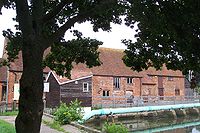
Eling Tide Mill
Encyclopedia
Eling Tide Mill, situated on an artificial causeway
in Eling
in Hampshire
, England
, is one of only two remaining operating tide mills in the United Kingdom
. The other is Woodbridge Tide Mill
. Whilst a mill is mentioned in the Domesday Book
of 1086, there is no evidence that there is any connection to the present mill. The current dam was rebuilt roughly two hundred years ago after storm damage.


 The tide mill
The tide mill
has a pair of independent waterwheels designed to drive a millstone
each. One wheel produces flour for sale, the other is kept as a static exhibit. The running wheel and its milling and other mechanisms are encased for safety of miller and visitors, the static wheel is immobile and kept that way to show visitors the detail that is obscured by the running mechanism's safety enclosures. The mill can be productive for between five and seven hours each day.
. A lease survives from the year 1418, when the College leased the mill to Thomas Mydlington, requiring him to maintain the mill and the causeway. The causeway was prone to collapse right up until 1940 when modern engineering calculations revealed the cause to be the design of the sluices. This was then corrected. The mill was out of action between 1946 and 1980 when it reopened.
Causeway
In modern usage, a causeway is a road or railway elevated, usually across a broad body of water or wetland.- Etymology :When first used, the word appeared in a form such as “causey way” making clear its derivation from the earlier form “causey”. This word seems to have come from the same source by...
in Eling
Totton and Eling
Totton and Eling is a town and civil parish in Hampshire, UK, with a population of around 28,000 people. It is situated on the eastern edge of the New Forest and on the River Test, close to the city of Southampton and part of the city's urban area...
in Hampshire
Hampshire
Hampshire is a county on the southern coast of England in the United Kingdom. The county town of Hampshire is Winchester, a historic cathedral city that was once the capital of England. Hampshire is notable for housing the original birthplaces of the Royal Navy, British Army, and Royal Air Force...
, England
England
England is a country that is part of the United Kingdom. It shares land borders with Scotland to the north and Wales to the west; the Irish Sea is to the north west, the Celtic Sea to the south west, with the North Sea to the east and the English Channel to the south separating it from continental...
, is one of only two remaining operating tide mills in the United Kingdom
United Kingdom
The United Kingdom of Great Britain and Northern IrelandIn the United Kingdom and Dependencies, other languages have been officially recognised as legitimate autochthonous languages under the European Charter for Regional or Minority Languages...
. The other is Woodbridge Tide Mill
Woodbridge Tide Mill
Woodbridge Tide Mill in Woodbridge, Suffolk, England is a rare example of a tide mill whose water wheel still turns.The mill has been preserved and is open to the public, its machinery reflects the skills and achievements of the early Industrial Revolution. The mill is a three storey building...
. Whilst a mill is mentioned in the Domesday Book
Domesday Book
Domesday Book , now held at The National Archives, Kew, Richmond upon Thames in South West London, is the record of the great survey of much of England and parts of Wales completed in 1086...
of 1086, there is no evidence that there is any connection to the present mill. The current dam was rebuilt roughly two hundred years ago after storm damage.
The mill



Tide mill
A tide mill is a water mill driven by tidal rise and fall. A dam with a sluice is created across a suitable tidal inlet, or a section of river estuary is made into a reservoir. As the tide comes in, it enters the mill pond through a one way gate, and this gate closes automatically when the tide...
has a pair of independent waterwheels designed to drive a millstone
Millstone
Millstones or mill stones are used in windmills and watermills, including tide mills, for grinding wheat or other grains.The type of stone most suitable for making millstones is a siliceous rock called burrstone , an open-textured, porous but tough, fine-grained sandstone, or a silicified,...
each. One wheel produces flour for sale, the other is kept as a static exhibit. The running wheel and its milling and other mechanisms are encased for safety of miller and visitors, the static wheel is immobile and kept that way to show visitors the detail that is obscured by the running mechanism's safety enclosures. The mill can be productive for between five and seven hours each day.
History
For much of the mill's life it has been owned by Winchester CollegeWinchester College
Winchester College is an independent school for boys in the British public school tradition, situated in Winchester, Hampshire, the former capital of England. It has existed in its present location for over 600 years and claims the longest unbroken history of any school in England...
. A lease survives from the year 1418, when the College leased the mill to Thomas Mydlington, requiring him to maintain the mill and the causeway. The causeway was prone to collapse right up until 1940 when modern engineering calculations revealed the cause to be the design of the sluices. This was then corrected. The mill was out of action between 1946 and 1980 when it reopened.
External links
- Eling Tide Mill
- Former website
- The Rarest Tide Mill by David Plunkett, Proceedings of the First Mill Research Conference, 1983

